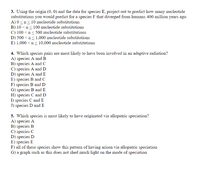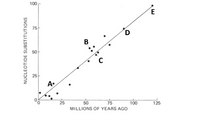
Calculus: Early Transcendentals
8th Edition
ISBN: 9781285741550
Author: James Stewart
Publisher: Cengage Learning
expand_more
expand_more
format_list_bulleted
Question
Using the graph answer the following questions. I need help answering the questions. I'm not sure about them.

Transcribed Image Text:3. Using the origin (0, 0) and the data for species E, project out to predict how many nucleotide
substitutions you would predict for a species F that diverged from humans 400 million years ago.
A) 0<ns 10 nucleotide substitutions
B) 10 <ng 100 nucleotide substitutions
C) 100 <n< 500 nucleotide substitutions
D) 500 <n< 1,000 nucleotide substitutions
E) 1,000 <n< 10,000 nucleotide substitutions
4. Which species pairs are most likely to have been involved in an adaptive radiation?
A) species A and B
B) species A and C
C) species A and D
D) species A and E
E) species B and C
F) species B and D
G) species B and E
H) species C and D
I) species C and E
J) species D and E
5. Which species is most likely to have originated via allopatric speciation?
A) species A
B) species B
C) species C
D) species D
E) species E
F) all of these species show this pattern of having arisen via allopatric speciation
G) a graph such as this does not shed much light on the mode of speciation

Transcribed Image Text:100
E
75
D
A.
50
75
100
MILLIONS OF YEARS AGO
125
NUCLEOTIDE SUBSTITUTIONS
Expert Solution
This question has been solved!
Explore an expertly crafted, step-by-step solution for a thorough understanding of key concepts.
This is a popular solution
Trending nowThis is a popular solution!
Step by stepSolved in 3 steps with 3 images

Knowledge Booster
Similar questions
- On graph below click the drop line and place the point where the two lines S1 and D1 intersectarrow_forwardI need help altering the graph.arrow_forwardUse the graph below to answer the questions. Clearly explain your thinking. John’s journey is graphed in RED and Bill’s in GREEN. A) What distance did John travel in the first 5 hours?arrow_forward
- Please answer all parts. Thanks.arrow_forwardPlease type out your solution so that I may be able to read them I have bad eyesight it can be hard for me to read handwriting I would appreciate it if you would type it out so that it may be easier for me to read and so that I may be able to zoom in if neededarrow_forwardPlease type out your solution so that I may be able to read them I have bad eyesight it can be hard for me to read handwriting I would appreciate it if you would type it out so that it may be easier for me to read and so that I may be able to zoom in if neededarrow_forward
arrow_back_ios
arrow_forward_ios
Recommended textbooks for you
 Calculus: Early TranscendentalsCalculusISBN:9781285741550Author:James StewartPublisher:Cengage Learning
Calculus: Early TranscendentalsCalculusISBN:9781285741550Author:James StewartPublisher:Cengage Learning Thomas' Calculus (14th Edition)CalculusISBN:9780134438986Author:Joel R. Hass, Christopher E. Heil, Maurice D. WeirPublisher:PEARSON
Thomas' Calculus (14th Edition)CalculusISBN:9780134438986Author:Joel R. Hass, Christopher E. Heil, Maurice D. WeirPublisher:PEARSON Calculus: Early Transcendentals (3rd Edition)CalculusISBN:9780134763644Author:William L. Briggs, Lyle Cochran, Bernard Gillett, Eric SchulzPublisher:PEARSON
Calculus: Early Transcendentals (3rd Edition)CalculusISBN:9780134763644Author:William L. Briggs, Lyle Cochran, Bernard Gillett, Eric SchulzPublisher:PEARSON Calculus: Early TranscendentalsCalculusISBN:9781319050740Author:Jon Rogawski, Colin Adams, Robert FranzosaPublisher:W. H. Freeman
Calculus: Early TranscendentalsCalculusISBN:9781319050740Author:Jon Rogawski, Colin Adams, Robert FranzosaPublisher:W. H. Freeman
 Calculus: Early Transcendental FunctionsCalculusISBN:9781337552516Author:Ron Larson, Bruce H. EdwardsPublisher:Cengage Learning
Calculus: Early Transcendental FunctionsCalculusISBN:9781337552516Author:Ron Larson, Bruce H. EdwardsPublisher:Cengage Learning

Calculus: Early Transcendentals
Calculus
ISBN:9781285741550
Author:James Stewart
Publisher:Cengage Learning

Thomas' Calculus (14th Edition)
Calculus
ISBN:9780134438986
Author:Joel R. Hass, Christopher E. Heil, Maurice D. Weir
Publisher:PEARSON

Calculus: Early Transcendentals (3rd Edition)
Calculus
ISBN:9780134763644
Author:William L. Briggs, Lyle Cochran, Bernard Gillett, Eric Schulz
Publisher:PEARSON

Calculus: Early Transcendentals
Calculus
ISBN:9781319050740
Author:Jon Rogawski, Colin Adams, Robert Franzosa
Publisher:W. H. Freeman


Calculus: Early Transcendental Functions
Calculus
ISBN:9781337552516
Author:Ron Larson, Bruce H. Edwards
Publisher:Cengage Learning